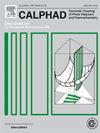Thermodynamic study on the phase diagram of the Hg-Ca and Hg-Sr binary systems for dental amalgam restoration application
IF 1.9
3区 材料科学
Q4 CHEMISTRY, PHYSICAL
Calphad-computer Coupling of Phase Diagrams and Thermochemistry
Pub Date : 2024-10-13
DOI:10.1016/j.calphad.2024.102755
引用次数: 0
Abstract
Dental amalgam, known for its biocompatibility and ductility, is widely used in restorative materials. In dental crown restorations, studying the interactions between amalgam fillings and crown tissues, particularly the roles of calcium (Ca) and strontium (Sr), is essential for improving function stability and biocompatibility. This study conducts critical literature evaluation and thermodynamic optimization of binary systems involving mercury (Hg) with Ca and Sr, focusing specifically on their suitability for dental amalgam restoration. Using first-principles calculations (FPC), the enthalpies of formation for compounds within the Hg-Ca and Hg-Sr binary systems were calculated in this work. Thermodynamic modeling of the liquid solution employed the modified quasichemical model in the pair approximation (MQM), uncovering significant short-range ordering. Conversely, solid phases were modeled using the compound energy formalism (CEF). The incorporation of FPC proves to be a valuable and effective method, providing essential insights to complement the calculation of phase diagrams (CALPHAD) modeling approach. Ultimately, this research significantly enhances our understanding of the thermodynamic characteristics of Hg-X alloys, with notable implications for their potential application in dental amalgam restoration.
牙科汞合金修复应用中汞-钙和汞-锶二元体系相图的热力学研究
牙科汞合金以其生物相容性和延展性著称,被广泛应用于修复材料中。在牙冠修复中,研究汞合金填料与牙冠组织之间的相互作用,特别是钙(Ca)和锶(Sr)的作用,对于提高功能稳定性和生物相容性至关重要。本研究对涉及汞(Hg)与钙(Ca)和锶(Sr)的二元体系进行了重要的文献评估和热力学优化,特别关注它们在牙科汞合金修复中的适用性。通过第一原理计算(FPC),本研究计算了汞-钙和汞-锶二元体系中化合物的形成焓。液态溶液的热力学建模采用了成对近似的修正准化学模型(MQM),发现了显著的短程有序性。相反,固相模型则采用了复能形式主义(CEF)。事实证明,结合 FPC 是一种宝贵而有效的方法,为相图计算 (CALPHAD) 建模方法提供了重要的补充。最终,这项研究极大地增强了我们对 Hg-X 合金热力学特性的理解,并对其在牙科汞合金修复中的潜在应用产生了显著影响。
本文章由计算机程序翻译,如有差异,请以英文原文为准。
求助全文
约1分钟内获得全文
求助全文
来源期刊
CiteScore
4.00
自引率
16.70%
发文量
94
审稿时长
2.5 months
期刊介绍:
The design of industrial processes requires reliable thermodynamic data. CALPHAD (Computer Coupling of Phase Diagrams and Thermochemistry) aims to promote computational thermodynamics through development of models to represent thermodynamic properties for various phases which permit prediction of properties of multicomponent systems from those of binary and ternary subsystems, critical assessment of data and their incorporation into self-consistent databases, development of software to optimize and derive thermodynamic parameters and the development and use of databanks for calculations to improve understanding of various industrial and technological processes. This work is disseminated through the CALPHAD journal and its annual conference.

 求助内容:
求助内容: 应助结果提醒方式:
应助结果提醒方式:


